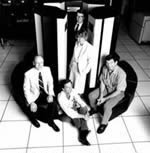Ohio Supercomputer Center Showcases Technology
US Representative Deborah Pryce (R-OH-15) hosted representatives from the Ohio Supercomputer Center and experts in high performance computing for a networking presentation on September 10 for members of the Congressional Internet Caucus and the Ohio Delegation to learn the educational value of the Internet.
 Empower. Partner. Lead. These are the philosophies and actions that define the Ohio Supercomputer Center’s two decades of innovation and service. And, as 2007 marks the Center’s 20th anniversary, the mission to empower, partner and lead state and national partners will guide the Center as it forges ahead as a center of excellence.
Empower. Partner. Lead. These are the philosophies and actions that define the Ohio Supercomputer Center’s two decades of innovation and service. And, as 2007 marks the Center’s 20th anniversary, the mission to empower, partner and lead state and national partners will guide the Center as it forges ahead as a center of excellence.